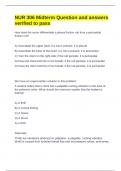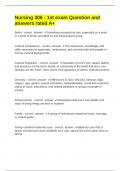-
1. Exam (elaborations) - 306 exam #1 questions with complete solution
-
2. Exam (elaborations) - 306 quiz 1 and answers correctly solved
-
3. Exam (elaborations) - An introduction to research— nur 306 ch. 1— 4 question and answers already passe...
-
4. Exam (elaborations) - Electrolytes-nur 306 questions with complete solution
-
5. Exam (elaborations) - Fetal age and characteristics (nur 306) question and answers already passed
-
6. Exam (elaborations) - Fluid and electrolyte (nurs 306) question and answers correctly solved
-
7. Exam (elaborations) - Health assessment final (nur 306) question and answers correctly solved
-
8. Exam (elaborations) - Nrs 306 pathophysiology mid term exam question and answers verified to pass
-
9. Exam (elaborations) - Nu 306 exam 1 practice questions with complete solution
-
10. Exam (elaborations) - Nur 306 - exam 1 question and answers already passed
-
11. Exam (elaborations) - Nur 306-quiz 2 question and answers 100% correct
-
12. Exam (elaborations) - Nur 306 - hair, skin, nails question and answers 100% correct
-
13. Exam (elaborations) - Nur 306: contraceptions questions with complete solution
-
14. Exam (elaborations) - Nur 306-quiz 9 question and answers 100% correct
-
15. Exam (elaborations) - Nur 306-quiz 6 question and answers 100% correct
-
16. Exam (elaborations) - Nur 306-quiz 7 question and answers rated a+
-
17. Exam (elaborations) - Nur 306: vsim amelia sung pre/pro-test question and answers verified to pass
-
18. Exam (elaborations) - Nur 306- chapter 13 question and answers correctly solved
-
19. Exam (elaborations) - Nur 306 ch. 11 murray state university nursing question and answers rated a+
-
20. Exam (elaborations) - Nur 306 cje 1: pancreatic enzyme replacements question and answers 100% correct
-
21. Exam (elaborations) - Nur 306 exam 1 question and answers 100% correct
-
22. Exam (elaborations) - Nur 306 exam 1 question and answers 100% correct
-
23. Exam (elaborations) - Nur 306 exam 1 questions with complete solution
-
24. Exam (elaborations) - Nur 306 exam 2 ch. 15-20, 24, 35 and 36 question and answers verified to pass
-
25. Exam (elaborations) - Nur 306 exam 2 question and answers 100% correct
-
26. Exam (elaborations) - Nur 306 exam 3 ch. 42, 34, 35, 25, 26, and 45 question and answers already passed
-
27. Exam (elaborations) - Nur 306 exam 3 ch. 42, 34, 35, 25, 26, and 45 question and answers correctly solved
-
28. Exam (elaborations) - Nur 306 exam 3 guided notes questions with complete solution
-
29. Exam (elaborations) - Nur 306 exam 3 question and answers rated a+
-
30. Exam (elaborations) - Nur 306 exam 3 question and answers verified to pass
-
31. Exam (elaborations) - Nur 306 exam 4 question and answers 100% correct
-
32. Exam (elaborations) - Nur 306 final exam question and answers rated a+
-
33. Exam (elaborations) - Nur 306 final exam question and answers rated a+
-
34. Exam (elaborations) - Nur 306 final exam questions with complete solution
-
35. Exam (elaborations) - Nur 306 final question and answers correctly solved
-
36. Exam (elaborations) - Nur 306 final (mwsu anderson) questions with complete solution
-
37. Exam (elaborations) - Nur 306 head and neck questions with complete solution
-
38. Exam (elaborations) - Nur 306 lab final question and answers already passed
-
39. Exam (elaborations) - Nur 306 midterm question and answers verified to pass
-
40. Exam (elaborations) - Nur 306 module 4 - vital signs and oxygenation question and answers rated a+
-
41. Exam (elaborations) - Nur 306 nclex powerpoint questions and answers rated a+
-
42. Exam (elaborations) - Nur 306 pharmacology exam 1 question and answers rated a+
-
43. Exam (elaborations) - Nur 306 prep u exam 1 practice question and answers already passed
-
44. Exam (elaborations) - Nur 306 prepu questions and answers in red correctly solved
-
45. Exam (elaborations) - Nur 306 question and answers correctly solved
-
46. Exam (elaborations) - Nur 306 quiz #1 question and answers already passed
-
47. Exam (elaborations) - Nur 306 test 1- ch 1, 4, 6, 7, 9, 22 & 23 question and answers verified to pass
-
48. Exam (elaborations) - Nur 306 test 2- ch 41 question and answers verified to pass
-
49. Exam (elaborations) - Nur 306 unit 12 question and answers 100% correct
-
50. Exam (elaborations) - Nur 306 week 5 question and answers already passed
-
51. Exam (elaborations) - Nur 306 week 5 question and answers correctly solved
-
52. Exam (elaborations) - Nur 306 week 6 (gi & renal) question and answers 100% correct
-
53. Exam (elaborations) - Nur 306 week 7 integumentary system question and answers 100% correct
-
54. Exam (elaborations) - Nur 306- exam 1 question and answers correctly solved
-
55. Exam (elaborations) - Nur 306-quiz 4 question and answers correctly solved
-
56. Exam (elaborations) - Nur 306 - exam 2 question and answers verified to pass
-
57. Exam (elaborations) - Nur 306 - exam 3 only sodium, potassium, and magnesium question and answers already p...
-
58. Exam (elaborations) - Nura 306 exam 1 module 1 question and answers already passed
-
59. Exam (elaborations) - Nura 306 exam 1 questions with complete solution
-
60. Exam (elaborations) - Nura 306 final exam nclex questions and answers verified to pass
-
61. Exam (elaborations) - Nura 306 module 1 question and answers 100% correct
-
62. Exam (elaborations) - Nurs 306: quiz 1 question and answers already passed
-
63. Exam (elaborations) - Nurs 306: exam 1 study guide question and answers correctly solved
-
64. Exam (elaborations) - Nurs 306-exam 1 questions with complete solution
-
65. Exam (elaborations) - Nurs 306 - exam 1 question and answers rated a+
-
66. Exam (elaborations) - Nurs 306: postpartum & new parenting (week 3+pca) ch 12, 13, & 16 question and answer...
-
67. Exam (elaborations) - Nurs 306: labor complications and obstetrical emergencies (week 6)-review question an...
-
68. Exam (elaborations) - Nurs 306 exam 1 chapters 1-6, 9 text: pharmacology for nurses university of nevada, l...
-
69. Exam (elaborations) - Nurs 306 exam 1 question and answers already passed
-
70. Exam (elaborations) - Nurs 306 exam 1 question and answers correctly solved
-
71. Exam (elaborations) - Nurs 306 exam 1 question and answers verified to pass
-
72. Exam (elaborations) - Nurs 306 exam 2 question and answers verified to pass
-
73. Exam (elaborations) - Nurs 306 exam 2 questions and answers verified to pass
-
74. Exam (elaborations) - Nurs 306 exam #3 question and answers verified to pass
-
75. Exam (elaborations) - Nurs 306 exam #2 question and answers correctly solved
-
76. Exam (elaborations) - Nurs 306 exam #1 question and answers rated a+
-
77. Exam (elaborations) - Nurs 306- respiratory question and answers rated a+
-
78. Exam (elaborations) - Nurs 306 final exam question and answers already passed
-
79. Exam (elaborations) - Nurs 306 final exam question and answers rated a+
-
80. Exam (elaborations) - Nurs 306 final exam questions with complete solution
-
81. Exam (elaborations) - Nurs 306 final exam sample q's from discussion board question and answers
-
82. Exam (elaborations) - Nurs 306 final practice q's and answers 100% correct
-
83. Exam (elaborations) - Nurs 306 module 2 question and answers 100% correct
-
84. Exam (elaborations) - Nurs 306 pharm exam 1 question and answers rated a+
-
85. Exam (elaborations) - Nurs 306 quiz 4 question and answers rated a+
-
86. Exam (elaborations) - Nurs 306 quiz 5 question and answers 100% correct
-
87. Exam (elaborations) - Nurs 306 quiz #4 question and answers already passed
-
88. Exam (elaborations) - Nurs 306 - ob week 1 question and answers 100% correct
-
89. Exam (elaborations) - Nurse 306 quiz 1 question and answers correctly solved
-
90. Exam (elaborations) - Nursing 306 midterm quinnipiac questions with complete solution
-
91. Exam (elaborations) - Nursing 306 question and answers 100% correct
-
92. Exam (elaborations) - Nursing 306 - 1st exam question and answers rated a+
-
93. Exam (elaborations) - Nut 306 final exam questions with complete solution
-
Show more





